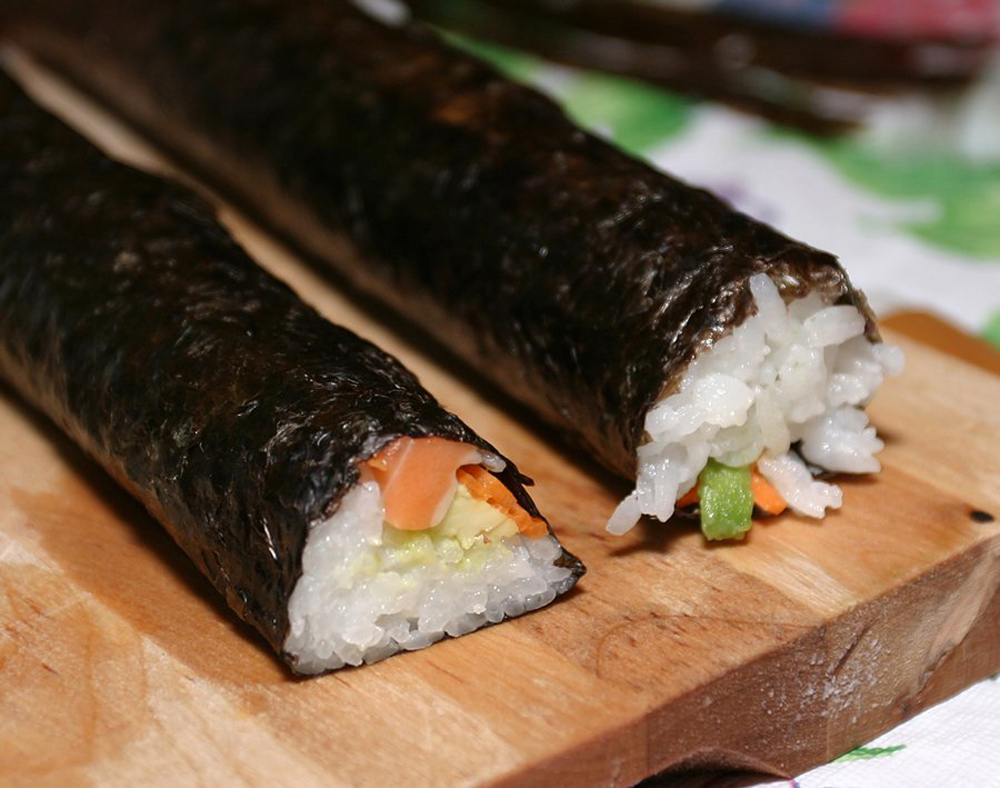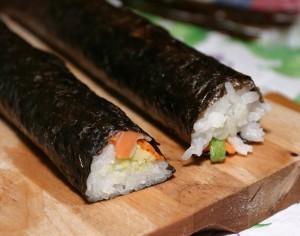
Going out for a sushi dinner on a Friday night may be an option, but some Drexel students chose to learn how to make their own Japanese signature dishes. The Honors Student Advisory Committee and the Japanese Undergraduate Student Association hosted Sushi and Onigiri Night Oct. 11 in the James E. Marks Intercultural Center.
Dominick Arp, a freshman marketing major, said, “We learned how to roll sushi, the proper technique for it, the best type of rice to use. We used the sticky rice. We also learned how to fold sushi to make little balls with [a] special surprise in them. I had tuna; it was delicious. Other than that, we just kind of had a good time.”
Bonnie Vu, president of JUSA and a senior environmental engineering major, said the purpose of the event was “to bring everybody together [who is] interested in Japanese culture.”
On the first-floor gallery of the Intercultural Center, participants were divided into two groups. One group sitting at two round tables learned how to make sushi — cylindrical pieces with rice and a choice of vegetables or protein. The other group learned how to make onigiri — rice balls with fillings inside.
Alison Yu, a senior biological sciences major and JUSA’s vice-president, and Hanna Itokazu, a sophomore culinary science major and secretary of JUSA, demonstrated how to make sushi rolls. Each participant was given a bamboo mat, one sheet of nori (an edible type of seaweed), rice, and fillings consisting of imitation crab, sliced carrots, cucumbers, avocado and thin omelets.
Participants needed to wet their hands with water or sesame oil to keep the rice from sticking to their hands. First, they placed the nori sheet onto the bamboo mat with the rough side facing up and spread a moderate layer of rice on about two-thirds of the nori. The rice used for sushi needs to be initially mixed with vinegar and sugar as a vinaigrette. Then they lined up slices of fillings along the rice and rolled from the bottom. The key is to roll tightly so that the fillings will not fall out when it is cut into slices.
Arp shared thoughts from his first sushi-making experience: “The trickiest part would be the actual rolling itself because it’s really weird the way [the filling] rolls around in there. But using the bamboo mat is actually a lot easier and then with the oil, a lot stickier.”
On the other side of the room was the onigiri demonstration table. Vu and Yu-sen “John” Liu, a pre-junior architectural engineering major and graphic designer for JUSA, did the demonstration.
“I learned how to make onigiri, which I had tried before but I never actually [knew] how to make,” Elizabeth Cahill, a sophomore international business major, said. “It’s like a Japanese equivalent to a sandwich.”
Similar to sushi rolls, the rice has to be marinated and the makers must wet their hands. Two available filling options for the onigiri were “umebosh,” a kind of sweet plum, and tuna mixed with mayonnaise. Participants first had to get a handful of rice and roll it into a ball. Then they pressed their thumbs into it to make a deep hole inside the ball to insert the fillings before folding rice over the hole. They molded the ball into a triangular shape by making an L shape with both their hands, pointing their thumbs out and closing the other fingers. The onigiri was finished with a small piece of nori and dipped into rice seasoning — a compound of minced seaweed, sesame, shrimp powder and other spices.
“It was challenging at first, but once you get the hang of it, once you get the rice really sticky, it’s pretty easy to mold it, and I think you can do a lot of really cool things with it. I’m interested to see what else you can do with it,” Arp said about his onigiri experience.
Liu, who had had previous experience making sushi and onigiri, shared some tips. The first was sanitation.
“Make sure your hands and tools are clean. Wash your hands as much as you can. I like using water to wet my hands so that the rice doesn’t stick as much to my hands,” Liu said. He continued explaining how water also helps sushi makers to mold faster and add adhesiveness to the rice. His second tip was preparation. It is essential to know what to add and how each ingredient tastes. “You can experiment [with] whatever you want,” he said.
Other students also enjoyed their Japanese final products.
“I’m really happy they’re doing this. I wouldn’t have had a chance to make sushi like this anywhere else, I think. But I’m also glad it’s open for all students, not just honors students. I think that’s a good idea too,” Gayle Tadler, a sophomore majoring in finance, said while holding her onigiri. “Incredible. They’re delightful.”
The event was so successful that 40 students attended when only 30 reserved slots.
“I was actually really happy. A lot [more] people came than I expected,” Danielle Kot, a business major and the cultural affairs director of HSAC who organized the event, said. “It was raining, so I didn’t expect many people would come.”
“I thought it was great. We didn’t really know what to expect because it’s the first time we did an event like this,” Melanie Jeske, a junior majoring in environmental studies and economics who also serves as the president of HSAC, said.
According to Kot, “Every quarter we do two cultural events. One of them is, I wanted to incorporate Japanese culture and I thought it would be popular. I think a lot of people love sushi but they don’t know how to make it.”
She added, “This year, Drexel has a lot more international students, so that’s why we’re trying to come up with more cultural events.”
“I came up with the idea sometime in August, and I contacted the JUSA, Bonnie. And we’ve been planning ever since. It didn’t take that much planning, but what took a lot of time was yesterday; we had to make the ingredients. That took a lot of time — cutting the carrots, the cucumbers, the rice took forever.”
This is also the first cultural event of the fiscal year for JUSA. “So you want to try to spread Japanese culture for people to know what they eat there, how they make it. And obviously it’s really easy to make,” Vu said.
Liu shared similar sentiment: “I’m actually not Japanese, like many of us here, but we do appreciate and respect the Japanese culture. So we’d like to spread Japanese traditions and culture around whoever is interested in learning.”
The post Students craft their own sushi appeared first on The Triangle.



